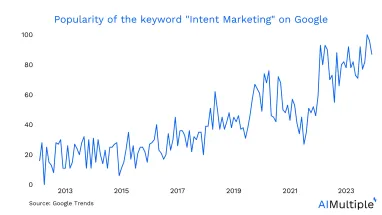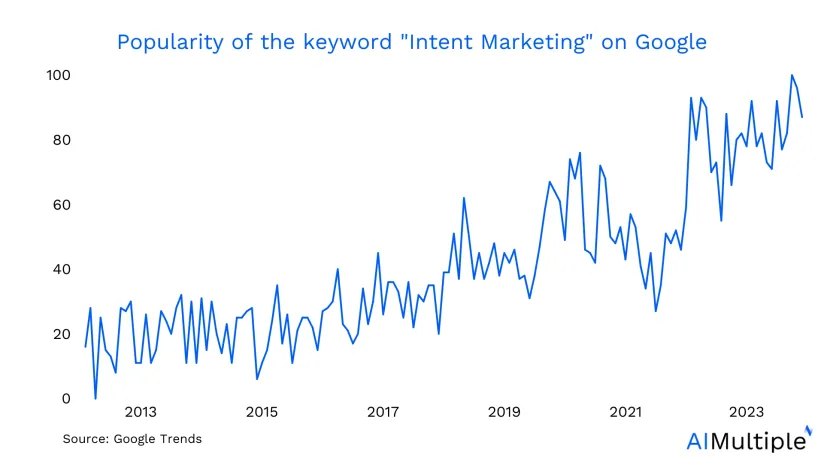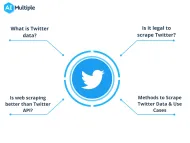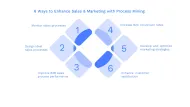Intent Marketing: Overview, How-to, 3 Challenges & Best Practices


Intent marketing aims to affect prospect purchase decision by analyzing consumer behavior. By leveraging intent marketing, 64% of companies reported improvement in return on investment and conversion rates.
What is Intent Marketing?
Intent marketing is a marketing practice relying on identifying and meeting the intent of the customer. Intent refers to what customers want or need in a given period. Intent-based marketing helps marketers determine a brand’s real audience and their purchase behavior at any particular time.
How does intent marketing work?
Intent marketing works through intent data. Intent data reflects users’ digital footprints when they search a keyword on a search engine, visit a website, or interact with content on social platforms. Intent data sources include:
- search engines
- site data
- off-site web activity
- point-of-sale
- CRM
- social data
- content consumption data
Search marketing (SEO and SEO marketing) is a well-known way to achieve intent marketing. In search marketing, potential customers’ intentions are detected in their online behavior. The sites they visit or revisit, the amount of time they spend on a specific type of content, and keywords related to certain contents reveal their intent.
By analyzing this intent data over time, businesses can identify customer behavior trends by analyzing the customer’s journey starting from recurring search engine queries to the engagement and clicks within a website, and the overall conversion rate (e.g. rate of purchase, appointment, sign, or in-store visit).
In addition to examining their customer intent data, marketers also track more comprehensive trends like intent indicators in search. “Buy”, “visit” and “purchase” are explicit keyword which reflect intents to execute. Based on these variables, a customers behavior can be predicted.
Why is intent marketing important?
The interest in intent marketing has seen a growth in the past ten years as businesses are trying to:
Understand the buyer environment
An individual’s final purchase is influenced by various actors apparent at different transaction stages. The entire process that starts with consumer’s necessity to purchase a product/ service contains engagement with google search, online market place search and social media ads. By analyzing intent data, marketers can reach these purchase-influencing features earlier. For example:
According to Google data, 40% of all baby product shoppers live in households without children. Therefore, businesses solely focus on demographics to sell baby products misses 40 % of customers.
Optimize their reach out strategies:
By adopting a marketing strategy that utilizes intent data, businesses can find out what their target customers are browsing for and what they are making inquires about. By doing so, they can optimize their reach out strategy and target them with customized campaigns and ads.
Increase ROI
With intent-based marketing, businesses concentrate on the right leads at the right moment; they maximize earnings by driving more conversions. Therefore, by pushing up an intent-based marketing budget, companies increase their ROI. For example, Google reports that ads relied on intent data provide 30% higher consideration lift and 40% higher purchase intent lift.
Optimize marketing content
Intent-based marketing provides more insight into the customer buying journey. For example, businesses discover buyer intent keywords and can update their content strategy accordingly.
Improve customer purchase experience
Businesses can use intent data, which includes customers’ reviews and rankings, to understand problems that customers undergo, product/service features they are interested in, etc. By meeting these specific needs in sales processes, businesses can improve their prospective buyers’ purchase experience.
What are the challenges facing intent marketing?
Data quality
Inadequate quality data is a challenge that faces implementing intent marketing. In order to identify purchase signals, data collection must be performed flawlessly. It is recommended to work with an intent data provider in cases where data quality is an issue.
Integrating existing data with intent data
For intent marketing, intent data should be combined with the existing lead scoring systems. Yet, higher numbers of data sources increase the complexity involved in organizing this data.
Time management
Using intent data wisely is another challenge. Companies may fail at optimizing their reach out strategy, such as bombarding prospect customers with ads or messages, or disappearing for a long period in a way that makes customers seek alternatives.
How to implement intent-marketing?
A company establishes intent marketing by creating content about its products/services. Every click on these content features generates usable data for the intent marking strategy or campaigns.
To generate intent data sources and implement intent marketing, businesses can follow these best practices:
Competitor analysis:
- Research competitor websites and study the information they provide in comparison to your company.
- Search for online content which mentions competitors in order to highlight what you offers as an alternative to each competitor.
Market analysis:
- Review listing websites (e.g. AIMultiple lists, G2, TrustRadius) to understand market landscape.
- Check review websites: Review websites may provide articles on the top performers in specific industries or about branded products or services.
Content optimization:
- Make sure to mention your brand’s novel aspects, such as awards, exceeding revenue expectations, or unique products.
- Try to receive numerous reviews as more reviews bring higher leads than before. At the end of the article or webpage, you can ask the reader to rate your content, or ask questions to generate an open conversation.
To discover more on ways artificial intelligence developments in marketing checkout our article on AI in Marketing: Comprehensive Guide.
If you think you need guidance with implementing intent marketing, let us walk you through the process and find the right vendor:



Comments
Your email address will not be published. All fields are required.